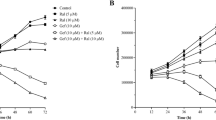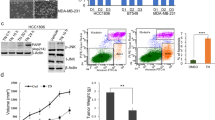Abstract
Aberrant activation of eIF4E signalling pathway is common in breast cancer and holds potential therapeutic options. In our work, galeterone as a chemical compound under clinical trials for the treatment of prostate cancer, was identified to be effective in targeting breast cancer cells via suppressing MNK-eIF4E and β-catenin. In despite of varying IC50, galeterone at nanomolar concentrations significantly decreased viability, proliferation and migration of a panel of breast cancer cell lines regardless of clinical subtypes and genetic mutations, and to a higher extent than in normal breast cells. Galeterone significantly enhanced the effects of chemotherapeutic drugs in reducing proliferation and viability but not migration. The in vivo efficacy of galeterone as single drug alone and its ability in augmenting chemotherapy’s efficacy were also shown in breast cancer xenograft mouse model. Mechanism analysis demonstrated that galeterone decreased MNK1/2 level and phosphorylation of eIF4E. In addition, galeterone decreased β-catenin level via promoting GSK-3β-mediated β-catenin degradation, and furthermore that Akt but not CK1 was involved in β-catenin degradation by galeterone. Rescue studies demonstrated that both MNK/eIF4E and β-catenin were responsible for anti-breast cancer activity of galeterone. Our study provides pre-clinical evidence to initialize clinical trials for breast cancer using galeterone in combination with chemotherapy.





Similar content being viewed by others
References
Dubey AK, Gupta U, Jain S (2015) Breast cancer statistics and prediction methodology: a systematic review and analysis. Asian Pac J Cancer Prev 16(10):4237–4245
Ribnikar D, Ratosa I, Perhavec A, Amir E (2017) General overview and treatment recommendations for young women with breast cancer. Rev Invest Clin 69(2):77–93. https://doi.org/10.24875/ric.17002175
Foulkes WD, Smith IE, Reis-Filho JS (2010) Triple-negative breast cancer. N Engl J Med 363(20):1938–1948. https://doi.org/10.1056/NEJMra1001389
Bianchini G, Balko JM, Mayer IA, Sanders ME, Gianni L (2016) Triple-negative breast cancer: challenges and opportunities of a heterogeneous disease. Nat Rev Clin Oncol 13(11):674–690. https://doi.org/10.1038/nrclinonc.2016.66
Larsson O, Li S, Issaenko OA, Avdulov S, Peterson M, Smith K, Bitterman PB, Polunovsky VA (2007) Eukaryotic translation initiation factor 4E induced progression of primary human mammary epithelial cells along the cancer pathway is associated with targeted translational deregulation of oncogenic drivers and inhibitors. Cancer Res 67(14):6814–6824. https://doi.org/10.1158/0008-5472.CAN-07-0752
Bhat M, Robichaud N, Hulea L, Sonenberg N, Pelletier J, Topisirovic I (2015) Targeting the translation machinery in cancer. Nat Rev Drug Discov 14(4):261–278. https://doi.org/10.1038/nrd4505
Mamane Y, Petroulakis E, Martineau Y, Sato TA, Larsson O, Rajasekhar VK, Sonenberg N (2007) Epigenetic activation of a subset of mRNAs by eIF4E explains its effects on cell proliferation. PLoS ONE 2(2):e242. https://doi.org/10.1371/journal.pone.0000242
Altman JK, Szilard A, Konicek BW, Iversen PW, Kroczynska B, Glaser H, Sassano A, Vakana E, Graff JR, Platanias LC (2013) Inhibition of Mnk kinase activity by cercosporamide and suppressive effects on acute myeloid leukemia precursors. Blood 121(18):3675–3681. https://doi.org/10.1182/blood-2013-01-477216
Hou J, Lam F, Proud C, Wang S (2012) Targeting Mnks for cancer therapy. Oncotarget 3(2):118–131. https://doi.org/10.18632/oncotarget.453
Ueda T, Watanabe-Fukunaga R, Fukuyama H, Nagata S, Fukunaga R (2004) Mnk2 and Mnk1 are essential for constitutive and inducible phosphorylation of eukaryotic initiation factor 4E but not for cell growth or development. Mol Cell Biol 24(15):6539–6549. https://doi.org/10.1128/MCB.24.15.6539-6549.2004
Li Z, Sun Y, Qu M, Wan H, Cai F, Zhang P (2017) Inhibiting the MNK-eIF4E-beta-catenin axis increases the responsiveness of aggressive breast cancer cells to chemotherapy. Oncotarget 8(2):2906–2915. https://doi.org/10.18632/oncotarget.13772
Ramalingam S, Gediya L, Kwegyir-Afful AK, Ramamurthy VP, Purushottamachar P, Mbatia H, Njar VC (2014) First MNKs degrading agents block phosphorylation of eIF4E, induce apoptosis, inhibit cell growth, migration and invasion in triple negative and Her2-overexpressing breast cancer cell lines. Oncotarget 5(2):530–543. https://doi.org/10.18632/oncotarget.1528
Wheater MJ, Johnson PW, Blaydes JP (2010) The role of MNK proteins and eIF4E phosphorylation in breast cancer cell proliferation and survival. Cancer Biol Ther 10(7):728–735. https://doi.org/10.4161/cbt.10.7.12965
Lim S, Saw TY, Zhang M, Janes MR, Nacro K, Hill J, Lim AQ, Chang CT, Fruman DA, Rizzieri DA, Tan SY, Fan H, Chuah CT, Ong ST (2013) Targeting of the MNK-eIF4E axis in blast crisis chronic myeloid leukemia inhibits leukemia stem cell function. Proc Natl Acad Sci USA 110(25):E2298-2307. https://doi.org/10.1073/pnas.1301838110
Mukherjee N, Panda CK (2020) Wnt/beta-catenin signaling pathway as chemotherapeutic target in breast cancer: an update on pros and cons. Clin Breast Cancer. https://doi.org/10.1016/j.clbc.2020.04.004
Bastos DA, Antonarakis ES (2016) Galeterone for the treatment of advanced prostate cancer: the evidence to date. Drug Des Dev Ther 10:2289–2297. https://doi.org/10.2147/DDDT.S93941
Kwegyir-Afful AK, Bruno RD, Purushottamachar P, Murigi FN, Njar VC (2016) Galeterone and VNPT55 disrupt Mnk-eIF4E to inhibit prostate cancer cell migration and invasion. FEBS J 283(21):3898–3918. https://doi.org/10.1111/febs.13895
Kwegyir-Afful AK, Murigi FN, Purushottamachar P, Ramamurthy VP, Martin MS, Njar VCO (2017) Galeterone and its analogs inhibit Mnk-eIF4E axis, synergize with gemcitabine, impede pancreatic cancer cell migration, invasion and proliferation and inhibit tumor growth in mice. Oncotarget 8(32):52381–52402. https://doi.org/10.18632/oncotarget.14154
Kharas MG, Deane JA, Wong S, O’Bosky KR, Rosenberg N, Witte ON, Fruman DA (2004) Phosphoinositide 3-kinase signaling is essential for ABL oncogene-mediated transformation of B-lineage cells. Blood 103(11):4268–4275. https://doi.org/10.1182/blood-2003-07-2193
Chou TC (2010) Drug combination studies and their synergy quantification using the Chou-Talalay method. Cancer Res 70(2):440–446. https://doi.org/10.1158/0008-5472.CAN-09-1947
Thorne CA, Hanson AJ, Schneider J, Tahinci E, Orton D, Cselenyi CS, Jernigan KK, Meyers KC, Hang BI, Waterson AG, Kim K, Melancon B, Ghidu VP, Sulikowski GA, LaFleur B, Salic A, Lee LA, Miller DM 3rd, Lee E (2010) Small-molecule inhibition of Wnt signaling through activation of casein kinase 1alpha. Nat Chem Biol 6(11):829–836. https://doi.org/10.1038/nchembio.453nchembio.453
Sorlie T, Perou CM, Tibshirani R, Aas T, Geisler S, Johnsen H, Hastie T, Eisen MB, van de Rijn M, Jeffrey SS, Thorsen T, Quist H, Matese JC, Brown PO, Botstein D, Lonning PE, Borresen-Dale AL (2001) Gene expression patterns of breast carcinomas distinguish tumor subclasses with clinical implications. Proc Natl Acad Sci USA 98(19):10869–10874. https://doi.org/10.1073/pnas.191367098
Dai X, Cheng H, Bai Z, Li J (2017) Breast cancer cell line classification and its relevance with breast tumor subtyping. J Cancer 8(16):3131–3141. https://doi.org/10.7150/jca.18457
Clement-Lacroix P, Ai M, Morvan F, Roman-Roman S, Vayssiere B, Belleville C, Estrera K, Warman ML, Baron R, Rawadi G (2005) Lrp5-independent activation of Wnt signaling by lithium chloride increases bone formation and bone mass in mice. Proc Natl Acad Sci USA 102(48):17406–17411. https://doi.org/10.1073/pnas.0505259102
Grzmil M, Seebacher J, Hess D, Behe M, Schibli R, Moncayo G, Frank S, Hemmings BA (2016) Inhibition of MNK pathways enhances cancer cell response to chemotherapy with temozolomide and targeted radionuclide therapy. Cell Signal. https://doi.org/10.1016/j.cellsig.2016.06.005
Bramham CR, Jensen KB, Proud CG (2016) Tuning specific translation in cancer metastasis and synaptic memory: control at the MNK-eIF4E axis. Trends Biochem Sci 41(10):847–858. https://doi.org/10.1016/j.tibs.2016.07.008
Njar VC, Kato K, Nnane IP, Grigoryev DN, Long BJ, Brodie AM (1998) Novel 17-azolyl steroids, potent inhibitors of human cytochrome 17 alpha-hydroxylase-C17,20-lyase (P450(17) alpha): potential agents for the treatment of prostate cancer. J Med Chem 41(6):902–912. https://doi.org/10.1021/jm970568r
Soifer HS, Souleimanian N, Wu S, Voskresenskiy AM, Collak FK, Cinar B, Stein CA (2012) Direct regulation of androgen receptor activity by potent CYP17 inhibitors in prostate cancer cells. J Biol Chem 287(6):3777–3787. https://doi.org/10.1074/jbc.M111.261933
Yu Z, Cai C, Gao S, Simon NI, Shen HC, Balk SP (2014) Galeterone prevents androgen receptor binding to chromatin and enhances degradation of mutant androgen receptor. Clin Cancer Res 20(15):4075–4085. https://doi.org/10.1158/1078-0432.CCR-14-0292
Giovannelli P, Di Donato M, Galasso G, Di Zazzo E, Bilancio A, Migliaccio A (2018) The androgen receptor in breast cancer. Front Endocrinol 9:492. https://doi.org/10.3389/fendo.2018.00492
Geter PA, Ernlund AW, Bakogianni S, Alard A, Arju R, Giashuddin S, Gadi A, Bromberg J, Schneider RJ (2017) Hyperactive mTOR and MNK1 phosphorylation of eIF4E confer tamoxifen resistance and estrogen independence through selective mRNA translation reprogramming. Genes Dev 31(22):2235–2249. https://doi.org/10.1101/gad.305631.117
Acknowledgements
This work was supported by Teaching Reform Research Project of Medical Department of Wuhan University (Grant No. 2019037); the Guide Foundation of Renmin Hospital of Wuhan University (Grant No. RMYD2018M78); Fundamental Research Funds for the Central Universities of China (Grant No. 2042019kf0102) and National Natural Science Foundation of China (Grant No. 81700599).
Author information
Authors and Affiliations
Corresponding authors
Ethics declarations
Conflict of interest
All authors declare that they have no conflicts of interests.
Additional information
Publisher's Note
Springer Nature remains neutral with regard to jurisdictional claims in published maps and institutional affiliations.
Electronic supplementary material
Below is the link to the electronic supplementary material.
Rights and permissions
About this article
Cite this article
Xu, Y., Liao, S., Wang, L. et al. Galeterone sensitizes breast cancer to chemotherapy via targeting MNK/eIF4E and β-catenin. Cancer Chemother Pharmacol 87, 85–93 (2021). https://doi.org/10.1007/s00280-020-04195-w
Received:
Accepted:
Published:
Issue Date:
DOI: https://doi.org/10.1007/s00280-020-04195-w




